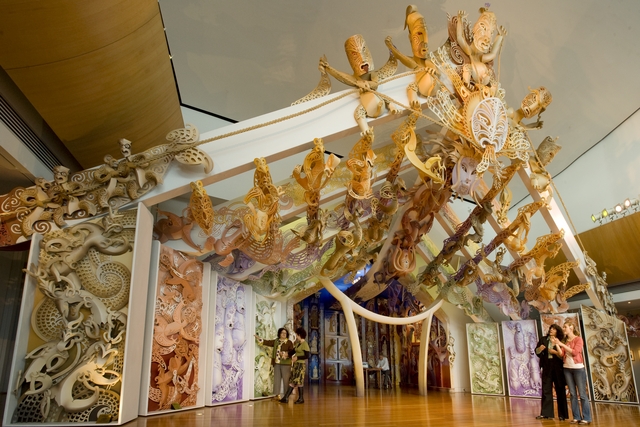“The most useful thing I learned at university was there is no one history and no one truth, and everything has to be looked into to understand the power dynamic behind what you are seeing,” says Courtney, who fell in love with art history while being taught by Christina Barton, Jenny Harper, Associate Professor Peter Brunt, and the late Associate Professor Roger Blackley in the early 2000s.

She worked at Te Papa for the first time as a student, in a host role. What she admired then about the place, and promulgates as tumu whakarae, is the thoroughly bicultural way in which it operates.
“It dovetailed with what I was learning at university. Having come from a very Pākehā upbringing, I learned more about Māori history, and came to understand this concept of being bicultural, developing an understanding of myself and my place in New Zealand. I was doing two lots of figuring things out—in the academic context and in the museums and galleries I was working at.”
Courtney is the first Te Papa chief executive to take a bilingual job title, and leads alongside kaihautū (Māori co-leader) Dr Arapata Hakiwai (Ngāti Kahungunu, Rongowhakaata, Ngāti Porou, Ngāi Tahu), who is also an alumnus of the University. This co-leadership structure began with inaugural kaihautū Cliff Whiting (Te Whānau-ā-Apanui) and chief executive Dame Cheryll Southeran.
It was a big drawcard for me, because I’m an intensely collaborative leader, and I get all my energy from people. My and Arapata’s commitment is to keep evolving Te Papa as a bicultural organisation, and what that means changes year by year and generation by generation.
“Te Papa was created quite early in the development of the Treaty of Waitangi settlement process, and now we’re moving into a different era as more and more iwi settle and can shift their energy into regrowth. So part of my and Arapata’s job is to shape how Te Papa shifts and grows to reflect that.”
Courtney loves museums for the service they provide to society and says Te Papa does this on many levels. “We are part of opening up to New Zealand the important conversations we need to be having as a society. I value the trust the public has in museums to do those jobs.”
One skill she works on as a museum leader is figuring out how to create ‘safe and brave’ spaces, negotiating the widely held concept that museums are a neutral space for people to come together.
“Museums are not neutral,” she says. “Museums are a colonial construct, they’re a power construct, a political construct, and they have a history of repressing voices and treating some people very poorly.
“You can’t just open your doors to any debate and say ‘we’re a safe space, come on in’, because that doesn’t necessarily make people who have felt unsafe feel more safe.”
As well as her roles leading museums, Courtney has held several governance roles, and is passionate about mentoring women into these.
“On both the Arts Wellington and the Museums Aotearoa boards, I’ve led development opportunities and provided board internships to demystify what governance is. Working in governance makes you better at working in organisations that are governed, because you understand the pressures your governance team are under and what they’re seeking to achieve.”
She has benefitted from people who have given her opportunities and says, “For people to give you opportunities, they need to know what you’re striving for. You have to say things out loud in order to make them real. So be open about your aspirations.
“And bear in mind your peer group of 22-year-olds today is your peer group of 32-year-olds, 42-year-olds as the decades go by. They will be the influencers. It is a lot easier to build outwards than to chase upwards.”





